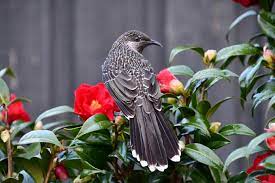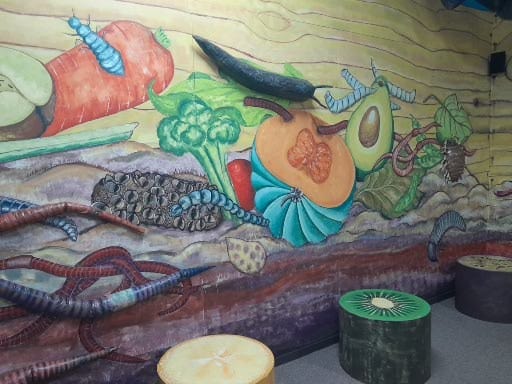Natural Links
-
Food Webs
-
Worms & Compost
-
Human Impacts
-
Species Interactions
Program Overview
Planet Earth is a complex environment that relies on delicate links and sophisticated relationships between living and non-living elements. This program gives students the opportunity to classify natural objects and organisms while exploring the interconnectedness and importance of a balanced environment. Students learn about human impacts and create actions for your school to support positive change.
This program can be tailored to suit different levels of understanding, from topic introduction through to topic consolidation.
Program Options and Activities
There are two options for this program. The 2hr program includes the first three activities listed below. The 4hr program contains all five activities.
Classification
Explore the characteristics and differences between living, previously living and non-living elements within a habitat through a hands-on classification activity.
Food Webs & Species Interconnectedness
Examine the complex relationships in nature across three continents during an interactive food web game.
Habitats and Survival (Mini Beasts, Plants and Birds)
Discover what birds and animals need to survive, then explore the gardens surrounding the Sustainability Centre and examine how the plants and animals are interconnected.
Compost Bin and Worms
Travel through our ‘Incredible Shrinking Machine” into our giant compost bin and explore the relationship between invertebrates and our food waste, meet our friendly earth worms (unclose and personal) and discover life that exists in our soil and the importance of soil healthy for food production and wellbeing.
Helping Habitats
By role playing animals that are typically found in urban wetland habitats, students get to explore animal needs, the impact of climate change and the impact humans have on their ability to survive. Students use the animals’ perspectives to think of positive changes that we can all make, to support local habitats such as creeks, lakes and parks to be healthy – as healthy habitats help reduce the impacts of climate change, give us great places to visit and provide a home to many precious local native plants and animals. Weather impacts on wetlands associated with Climate Change considered include: strong winds, flooding, rising sea levels, fire, longer droughts and seasonal irregularities.
Both programs conclude with:
Humans Impacts & Call to Action
Students will lead a discussion about how natural links are affected and/or disrupted by human activities and derive actions they can adopt to minimise their impact on the environment.
Certificate and Conservation Code to reinforce learnings
Post event, schools will be issued a Certificate of Participation and Conservation Code for each class which students are encouraged to sign and hang in the classroom as a reminder of their learnings and their commitment to protect the environment.
We encourage schools to connect with us a few weeks or months after school excursions to share behaviour changes made by the students or activities undertaken as a result of their learnings during their program so we can share success stories to inspire others, monitor the ongoing impact of our programs and make relevant updates or changes if required.
Restrictions: Group numbers can be limited on some days. More than 4 classes however can be accommodated by special request. Where possible please give min 4 weeks notice.
Curriculum Links
Science Understanding: Science as a Human Endeavour
Science knowledge helps people to understand the effects of their actions (VCSSU056)
Science Understanding: Biological Science
Living things have characteristics that distinguish them from non-living things and things that were once living, including fossils VC2S4U01
Plants and animals have different life cycles; offspring are similar, but not identical, to their parents VC2S4U02
Consumers, producers and decomposers have different roles and interactions within a habitat; food chains can be used to represent feeding relationships VC2S4U03
Science Understanding: Earth and Space Science
Water is an important Earth resource that originates from various sources; water cycles through the environment by moving through the sky, landscape and ocean, and involves processes including precipitation, evaporation, transpiration, condensation, melting, freezing, crystallisation, infiltration and run-off VC2S4U07
Science Inquiry: Processing, modelling and analysing
Data and information can be organised and represented to identify patterns and simple relationships by constructing tables, graphs and visual or physical models VC2S4I04
Sciency Inquiry: Questioning and predicting
Observations can be used as a basis for posing questions to identify patterns and relationships, and to predict the outcomes of investigations VC2S4I01
Geographical Knowledge | Diversity of places and environments
The relationships between people and their place and its environment VC2HG4K01
The importance of environments, including natural vegetation and water sources, to people and animals in Australia and on another continent VC2HG4K03
Sustainability and its application to the use of natural resources and the management of waste VC2HG4K09
Geographical Skills – Geographical Inquiry
identify and develop questions to guide a geographical inquiry on the diversity of places and environments VC2HG4S01
locate, collect and record information and data from a range of sources, including from fieldwork, maps, photographs and graphs VC2HG4S02
Represent and analyse information and data collected in different formats VC2HG4S03
Citizenship Knowledge and Understanding: Diversity and Understanding
Why people participate within communities and how students can actively participate and contribute to communities VC2HC4K07
English: Language for interacting with others
Understand that cooperation with others depends on shared understanding of social conventions, including turn-taking language, which vary according to the degree of formality VC2E3LA01
English: Literacy Interacting with others
Use interaction skills to contribute to conversations and discussions to share text- or topic-based information and ideas VC2E3LY01
Drama: Creating
Use a variety of dramatic forms and elements of drama to create real and imagined stories VC2ADR2C01
Drama: Presenting
Present and share drama that communicates ideas to audiences in informal settings VC2ADR2P01
The Victorian Curriculum F-10 content elements are © VCAA, reproduced by permission. Victorian Curriculum F-10 elements accurate at time of publication. The VCAA does not endorse or make any warranties regarding this resource. The Victorian Curriculum F-10 and related content can be accessed directly at the VCAA website.



